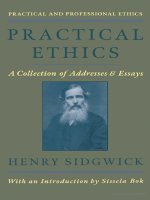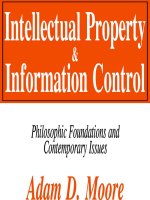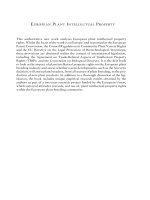ESSENTIALS of Licensing Intellectual Property docx
Bạn đang xem bản rút gọn của tài liệu. Xem và tải ngay bản đầy đủ của tài liệu tại đây (2.08 MB, 236 trang )
ESSENTIALS
of Licensing
Intellectual Property
ffirs.qxd 11/3/03 9:48 AM Page i
The Essentials Series was created for busy business advisory and corporate
professionals.The books in this series were designed so that these busy pro-
fessionals can quickly acquire knowledge and skills in core business areas.
Each book provides need-to-have fundamentals for those profes-
sionals who must:
•
Get up to speed quickly, because they have been promoted to
a new position or have broadened their responsibility scope
•
Manage a new functional area
•
Brush up on new developments in their area of responsibility
•
Add more value to their company or clients
Other books in this series include:
Essentials of Accounts Payable, Mary S. Schaeffer
Essentials of Capacity Management, Reginald Tomas Yu-Lee
Essentials of Cash Flow, H.A. Schaeffer, Jr.
Essentials of Corporate Performance Measurement, George T. Friedlob,
Lydia L.F. Schleifer, and Franklin J. Plewa, Jr.
Essentials of Cost Management, Joe and Catherine Stenzel
Essentials of CRM: A Guide to Customer Relationship Management,
Bryan Bergeron
Essentials of Credit, Collections, and Accounts Receivable,
Mary S. Schaeffer
Essentials of Financial Analysis, George T. Friedlob and
Lydia L. F. Schleifer
Essentials of Intellectual Property, Alexander I. Poltorak and
Paul J. Lerner
Essentials of Knowledge Management, Bryan Bergeron
Essentials of Licensing Intellectual Property, Alexander I. Poltorak and
Paul J. Lerner
Essentials of Patents, Andy Gibbs and Bob DeMatteis
Essentials of Payroll Management and Accounting, Steven M. Bragg
Essentials of Shared Services, Bryan Bergeron
Essentials of Supply Chain Management, Michael Hugos
Essentials of Treasury and Cash Management, Michele Allman-Ward
and James Sagner
Essentials of Trademarks and Unfair Competition, Dana Shilling
Essentials of XBRL, Bryan Bergeron
For more information on any of the above titles, please visit
www.wiley.com
.
Essentials Series
ffirs.qxd 11/3/03 9:48 AM Page ii
ESSENTIALS
of Licensing
Intellectual Property
Alexander I. Poltorak
Paul J. Lerner
John Wiley & Sons, Inc.
ffirs.qxd 11/3/03 9:48 AM Page iii
This book is printed on acid-free paper.
Copyright © 2004 by John Wiley & Sons, Inc. All rights reserved.
Published by John Wiley & Sons, Inc., Hoboken, New Jersey
Published simultaneously in Canada
No part of this publication may be reproduced, stored in a retrieval system, or
transmitted in any form or by any means, electronic, mechanical, photocopying,
recording, scanning, or otherwise, except as permitted under Section 107 or
108 of the 1976 United States Copyright Act, without either the prior written
permission of the Publisher, or authorization through payment of the
appropriate per-copy fee to the Copyright Clearance Center, Inc., 222
Rosewood Drive,Danvers,MA 01923,978-750-8400,fax 978-646-8600,or
should be addressed to the Permissions Department,John Wiley & Sons,Inc.,
111 River Street, Hoboken, NJ 07030, 201-748-6011, fax 201-748-6008.
Limit of Liability/Disclaimer of Warranty:While the publisher and author have
used their best efforts in preparing this book, they make no representations
or warranties with respect to the accuracy or completeness of the contents of
this book and specifically disclaim any implied warranties of merchantability or
fitness for a particular purpose. No warranty may be created or extended by
sales representatives or written sales materials. The advice and strategies
contained herein may not be suitable for your situation. You should consult
with a professional where appropriate. Neither the publisher nor author shall
be liable for any loss of profit or any other commercial damages, including but
not limited to special, incidental, consequential, or other damages.
For general information on our other products and services, or technical support,
please contact our Customer Care Department within the United States at
800-762-2974, outside the United States at 317-572-3993 or fax 317-572-4002.
Wiley also publishes its books in a variety of electronic formats. Some content
that appears in print may not be available in electronic books.
For more information about Wiley products, visit our web site at www.wiley.com.
Library of Congress Cataloging-in-Publication Data:
ISBN 0-471-43233-4
Printed in the United States of America
10 9 8 7 6 5 4 3 2 1
ffirs.qxd 11/3/03 9:48 AM Page iv
on the web at www.copyright.com.Requests to the Publisher for permission
∞
Alexander I. Poltorak is the founder and chief executive officer of
General Patent Corporation (GPC), an intellectual property (IP) man-
agement company focusing on patent licensing and enforcement, inter-
national technology transfer, and IP portfolio management. Prior to
establishing GPC in 1989, Dr. Poltorak was the president of Poltorak
Associates Inc., a management consulting and patent licensing firm,
which he formed in 1987. Before that he was chief executive officer of
Rapitech Systems, Inc., a publicly traded computer company that he
cofounded in 1983. Prior to Rapitech, Dr. Poltorak served as Assistant
Professor of Biomathematics at the Neurology Department of Cornell
University Medical College, where he conducted research in image
processing and computer tomography.He also served as Assistant Professor
of Physics at Touro College. Dr. Poltorak has published several papers
in scientific journals.
Dr. Poltorak emigrated from the former USSR in 1982, where he
was awarded a doctorate in physics at the age of 22 for a significant
breakthrough in Einstein’s Theory of Relativity. As a political dissident,
he was later stripped of his degrees for anticommunist activities. He is
a member of the Licensing Executives Society (LES), the Association of
University Technology Managers (AUTM), Intellectual Property Owners
Association (IPO), the National Association of Corporate Directors, the
New York Academy of Science, and the American Physical Society.
He was a US co-chairman for the Subcommittee on Information
Exchange of the US-USSR Trade and Economic Counsel. He is on the
advisory board of
Patent Strategy & Management
, for which he cowrote
v
About the Authors
ffirs.qxd 11/3/03 9:48 AM Page v
“Corporate Officers and Directors Can Be Liable for Mismanaging
Intellectual Property.” The article appeared in its May and June 2000
issues. He is coauthor with attorney Paul J. Lerner of an article about
Grain Processing v. American Maize Products
, “Grain, Grain, Go Away,”
which examines recent major developments in lost profits. The article
appeared in the February 2000 edition of
Intellectual Property Worldwide
.
In June of 2000 Dr. Poltorak delivered a lecture on technology transfer
from Russia at the International Technology Transfer Seminar organized
by the American Conference Institute.
Paul J. Lerner is the senior vice president and general counsel of
General Patent Corporation (GPC), an intellectual property (IP) man-
agement company focusing on patent licensing and enforcement, inter-
national technology transfer, and IP portfolio management. Before joining
GPC, Mr. Lerner was a partner in the Hartford, Connecticut, business
law firm of Pepe & Hazard LLP. He has led IP law departments at Olin
Corporation, Black & Decker Corporation, and multinational electrical
construction giant Asea Brown Boveri, Inc.
Prior to embarking on a law career, Mr. Lerner was a project man-
ager at the Illinois Institute of Technology Research Institute in Chicago,
where he managed a technology transfer and technology forecasting
team. Mr. Lerner’s education includes a BS in Aeronautical Engineering
from Purdue University, an MBA from Loyola University, a JD from
DePaul University, and postgraduate legal studies at John Marshall
College of Law. He is an adjunct professor of IP law at the University
of New Haven.
Mr. Lerner is a member of the Licensing Executives Society (LES)
and the American Intellectual Property Law Association (AIPLA). He
is coauthor with GPC’s chairman and CEO, Alexander I. Poltorak, of an
article about
Grain Processing v.American Maize Products
,“Grain, Grain,
Go Away,” which examined recent major developments in lost profits.
vi
About the Authors
ffirs.qxd 11/3/03 9:48 AM Page vi
The article appeared in the February 2000 edition of
Intellectual Property
Worldwide
. He also cowrote “Corporate Officers and Directors Can Be
Liable for Mismanaging Intellectual Property,” which appeared in the
May and June 2000 issues of
Patent Strategy & Management
. In September
2000 Mr. Lerner’s article “Strategic Auditing: The Key to Minimizing
Litigation Bills” was published by
corporateintelligence.com
.
General Patent Corporation is based in Montebello Park, Suffern,
New York, and has offices in Hungary, Russia, and Israel.
vii
About the Authors
ffirs.qxd 11/3/03 9:48 AM Page vii
ffirs.qxd 11/3/03 9:48 AM Page viii
ix
Foreword xi
Preface xv
1 Introduction 1
2 Basic Contract Law 7
3 Intellectual Property Primer 25
4 Licensing Strategies: The Carrot and the Stick 45
5 Patent Licenses 53
6 Know-how and Trade Secret Licenses 69
7 Trademark Licenses 79
8 Copyright Licenses 91
9 Royalties and Royalty Rates 99
10 Policing and Enforcement of Licenses 109
11 Negotiating the Deal 115
Appendices
A Checklist of Patent License Terms 123
B Royalty Rates by Industry 133
C Confidentiality and Nondisclosure Agreement 135
D Trademark License Agreement 139
E Patent License Agreement (Paid-Up) 149
Contents
ftoc.qxd 11/3/03 8:52 AM Page ix
F Patent License Agreement (Running Royalty) 163
G Software (End User) License Agreement 179
H Copyright License Agreement 185
I Technology License Agreement 191
J Georgia-Pacific Factors 203
K Agreement to Negotiate a License 205
Epilogue 209
Further Reading 211
Index 213
x
Contents
ftoc.qxd 11/3/03 8:52 AM Page x
T
he invention of e-mail as an efficient mode of communication
gives rise to an intriguing benefit: One need not answer a question
immediately as would be expected in real-time conversation.
Therefore, on occasion, I prefer to ponder before I answer, as I did
when honored with the request to write this preface to
Essentials of
Licensing Intellectual Property
.
My initial response was to decline, stating that I was too busy to
read yet another licensing book. Honestly, I really am too busy to plow
through more theoretical jargon. Too busy to pull out my calculator to
analyze complex royalty or valuation models. Too busy to hear one
more author sell me more pixie dust that magically turns patents into
winning lottery tickets.
As we have all witnessed in the recent past, countless books on
licensing IP have been written as best-seller novels to excite the soul
and incite a spark of larceny; maps that we should follow to discover
long-forgotten patent treasures that await discovery and exploitation.
Other patent licensing treatises are excellent examples of IP consult-
ants and theorists attempting to explain the complexity of IP law and the
mystical process of extracting value (money) from idle IP assets; ultimately
these works leave the reader feeling lost and helpless, believing that hiring
a consultant is the only way to profit from their unexploited IP.
I also felt that you, the reader, have lost your appetite for another
helping of licensing leftovers, too full of IP licensing prophesy to gulp
down yet another spoonful. Fortunately, this was one of those occasions
that I paused to contemplate.
xi
Foreword
fbetw.qxd 11/3/03 8:53 AM Page xi
Why? Because I owed it to two of the IP industry’s most respected
realists,Alexander Poltorak and Paul Lerner, and to the business and invest-
ment communities, to evaluate whether these authors could merge their
contemporary legal expertise with recognized firsthand licensing success
to create a hands-on IP licensing reference.
After reading and reflecting on this book, I clicked “reply” on my
e-mail and accepted their kind invitation.
This book is a fast, friendly, insightful read—I couldn’t put it down,
and consumed it cover to cover in a single sitting (except for a few
quick trips to refill my diet soda).
You’ll want to read
Essentials of Licensing Intellectual Property
for the
same reason you read any book on licensing. . . it’s a guide to generating
money. But while other books on licensing espouse a process to make
fast money,
Essentials of Licensing Intellectual Property
is an easy-to-use
tool that empowers you to become a fast learner on how to generate
revenue and increase shareholder value—not only from patents, but also
from trademarks, copyrights, mask works, and more.
IP management is a serious business in which fortunes can be made
or lost quickly. Managers of IP are held accountable to shareholders,
with the new financial accounting standards now requiring line-item
reporting of IP value. Interestingly, though, Poltorak and Lerner kept
me laughing throughout the book. Their storytelling style and tongue-
in-cheek euphemisms not only keep this book flowing quickly, but
they burn the most important concepts indelibly into the reader’s mind.
It’s light, but deep. It’s an overview, but it also clearly outlines
the steps necessary to build a profitable IP strategy and deploy smart
licensing tactics. It’s full of pointed tips and helpful advice that can
empower any manager to quickly obtain a solid, hands-on working
knowledge of the essentials of IP licensing. (Maybe that’s why it’s the
title of the book.)
xii
Foreword
fbetw.qxd 11/3/03 8:53 AM Page xii
Applicable to experienced and new MBAs, read this book and by
the end of the day, you’ll understand how to build traction for your IP
licensing strategy, enhancing your company’s most valuable and sustain-
able competitive advantage, its IP!
Managers, investors, and shareholders will quickly develop a mean-
ingful vocabulary and understanding of the essential legal and business
elements involved in IP licensing—and the incredible value that can be
realized if sensible management is applied to this licensing process.
Even experienced licensing professionals, who have become victims
of their own proclivity to migrate clear IP licensing objectives toward
complex licensing agreements, will find
Essentials of Licensing Intellectual
Property
to be a timely, snappy refresher.
If you’re looking for an ivory-tower book that will allow you to
impress the executive staff with your expansive but instant knowledge
of IP licensing theory and mastery of complex IP valuation models,
buy a different book. But if your objective is to gain an immediate
command of the practicalities of licensing IP assets, Poltorak and Lerner
have given you everything you need to hit the ground running by
Monday morning.
Although e-mail brought the promise of instant communication, I
wonder if it was ever envisioned as a method to pause and reflect before
continuing with the dialogue. This time, at least, I’m glad I did. For
insightful books like this, I’ll never be too busy!
Andy Gibbs
CEO, PatentCafe.com, Inc.
Coauthor,
Essentials of Patents
Second-term member, USPTO Public Patent Advisory Committee
Board of Directors, Intellectual Property Owners Association
xiii
Foreword
fbetw.qxd 11/3/03 8:53 AM Page xiii
fbetw.qxd 11/3/03 8:53 AM Page xiv
xv
O
f late, much has been written about intellectual property (IP) and
how it forms the modern basis for wealth. Readers are advised to
create intellectual property, by stimulating its generation and securing
its legal protection. They are advised to search their organizations for
undiscovered or “hidden” intellectual property, to “audit,” “mine,” and
“triage” their IP. Yet all of this effort, directed to the creation of intel-
lectual property or the identification of existing property, does not in
itself yield wealth.
Intellectual property is not wealth;it is a tool that, properly used, will
produce wealth. The potential wealth that IP represents is locked away
and is unlocked only when the property is utilized in the production of
goods or services for sale in the market. Such utilization, of course, may
be by the creator of the intellectual property. Yet often the IP creator is
unable to utilize it, to utilize it effectively, or to utilize it to its fullest
extent. In such circumstances, the property owner may assign (sell) the
property to a party better situated to its employ. Many IP owners, how-
ever, are reluctant or unwilling to sell it. Owners may, for example, wish
to retain the right to use the property themselves, either in the present
or in the future. Moreover, it may be difficult or impossible to find a
buyer willing and able to pay the price an IP owner deems appropriate.
How then is the owner to fully realize the potential value of the property?
The answer, of course, is licensing. The owner of intellectual property
may realize its value by licensing it to one or more parties who will uti-
lize it in the creation of goods and services. For all of the obvious
Preface
fpref.qxd 11/3/03 8:53 AM Page xv
importance of licensing, little attention has been directed to it, and
many business executives remain ignorant of its principles, its pitfalls,
and the opportunities it may present. This book discusses the basic issues
of licensing and the effective conversion of IP into real wealth.
Chapter 1 defines licensing, explains its advantages, and sets forth
principles for selecting those properties to be licensed and those to be
abandoned. Chapter 2 introduces the reader to the basic rules of contract
law, including the elements of a contract and the general structure of a
license. Chapter 3 provides a primer of the various types of intellectual
property—the subject of any license. Licensing strategies are discussed
in Chapter 4.
The book next addresses the particular issues involved in the licens-
ing of patents, know-how and trade secrets, trademarks, and copyrights
(Chapters 5 through 8, respectively). In Chapter 9, the different roles of
the “paid-up” and “running royalty” licenses are discussed, as well as the
factors that determine royalty rates. Chapter 10 addresses the policing
and enforcement of licenses, from the viewpoint of both licensor and
licensee. Finally, Chapter 11 deals with negotiation, addressing negotia-
tion skills and the rules for a successful negotiation. Chapter 11 is fol-
lowed by Appendices A–K and a list of suggested further reading.
xvi
Preface
fpref.qxd 11/3/03 8:53 AM Page xvi
Authors’ Note
The purpose of this book is to introduce business executives and inven-
tors to the principles underlying the licensing of intellectual property
in the business environment.The book describes key concepts and facts,
and illustrates how these concepts and facts should influence decision
making. Of necessity, these descriptions are generalized.
Exceptions abound to every rule stated in the following chapters.
(Your lawyer will be more than happy to enumerate these exceptions
for you.) Moreover, the law is a living, constantly evolving creature.The
rules of the game are constantly changing—often in midplay and some-
times retroactively.A little knowledge is a dangerous thing. Before making
important decisions, review matters with a qualified professional. Reading
this book, however carefully, is no substitute for professional guidance.
The authors wish to thank Susan McDermott of John Wiley &
Sons, Inc., for her patience and unfailing enthusiasm for this book.We
are also grateful to Nava Cooper for preparing the manuscript for pub-
lication and to Lisa Meyers for her help with typing the manuscript.
xvii
PrefacePreface
fpref.qxd 11/3/03 8:53 AM Page xvii
fpref.qxd 11/3/03 8:53 AM Page xviii
ESSENTIALS
of Licensing
Intellectual Property
flast.qxd 11/3/03 8:54 AM Page xix
flast.qxd 11/3/03 8:54 AM Page xx
1
After reading this chapter you will be able to
•
Understand what a license is
•
Understand why a license may be desirable
•
Know how to choose which intellectual property to license
and which to abandon
Background
What a License Is
A license is, simply stated, permission to do something the granting
party (the licensor) has the right to otherwise prohibit. In the context
of intellectual property (IP) licensing, it is a grant, by the owner of the
property, to another (the licensee) of this right to use the licensed rights
free of suit by the property owner, pursuant to certain terms and con-
ditions and subject to certain limitations.
The extent of the rights granted in a license may run the gamut
from a mere permission to use the licensed property in some limited
manner (a nonexclusive license) to all but ownership of the property (an
exclusive license). (For more on this topic, see Chapter 2.)
CHAPTER 1
Introduction
c01.qxd 11/3/03 8:56 AM Page 1
Interesting Facts
•
In the United States, royalties from patent licensing have
increased from $15 billion in 1990 to more than $110 billion
in 2000.
•
Licensing experts believe that a well-managed IP portfolio
should yield 1 percent of a firm’s revenues and 5 percent of its
net profits. At the same time, however, a recent survey found
that two-thirds of U.S. companies own IP that is neither used
internally nor licensed to others.
•
Investors value a dollar of royalty income four to five times as
highly as a dollar of operating earnings.
•
Intellectual property was deemed an important factor driving
mergers and acquisitions by 51 percent of surveyed business
executives.
Clearly, there is money to be made from licensing intellectual prop-
erty (and from writing books about licensing IP). More significantly, the
practice of such licensing is now so widespread and accepted as to be
expected by market analysts, shareholders, directors—and those who decide
on executives’ salaries and bonuses. Indeed, today it is the failure to
license which is deemed noteworthy—and unacceptable.
Why, Tell Me Why!
Why license your (or your firm’s) intellectual property? There are several
reasons. The most commonly heard, and still the most significant, is
money
. Licensing creates revenue. Most licenses bear royalties, either in the
form of a lump sum (a paid-up license) or periodic payments based on
sales (a running royalty license). Some licenses bear no royalties but are,
in effect, an exchange of rights between two IP owners (a cross license).
If, however, you consider the cost savings realized by securing a license
under the property of another without payment of a cash royalty, even
a cross license may be deemed to generate an imputed income.
2
ESSENTIALS of Licensing Intellectual Property
c01.qxd 11/3/03 8:56 AM Page 2
Beyond the mere generation of royalty income (by itself, no mean
accomplishment), licensing may be utilized as a vehicle for entry into new
geographic or product markets. A property owner may grant a license
allowing a licensee entry into a geographic market not served by the
licensor or allowing introduction of a product not offered by the licensor.
The licensee bears all of the risks attendant on such a new venture and pays
a royalty for the privilege. The licensor collects the royalty and observes
the licensee. If the licensee’s efforts prove successful, the licensor may
enter the market as well (assuming, of course, that the license was not
exclusive; more on this later). If, however, the licensee’s efforts end in
failure, the licensor has learned a valuable lesson at no cost to itself.
Somewhat ironically, licensing may, under some circumstances, also
serve to strengthen the licensor’s market position. Many firms will refuse
to purchase a product available only from a single source, thereby placing
themselves somewhat at the supplier’s mercy. Such firms will demand
that a patentee, for example, grant licenses to others (automobile man-
ufacturers are famous—or infamous—for this).
Licensees also may serve to provide variety and breadth of choice
in a market where a monopolist is able to offer only a limited product
line. Similarly, they may develop improvements or ancillary products or
services, all of which serve to increase the attractiveness of the basic,
licensed product. A moderate slice of a large pie may well be bigger
than all of a small pie.
Licensing also has the effect of strengthening the licensed proper-
ties. In part, this is the result of co-opting of potential infringers (i.e.,
converting them into licensees).With respect to patents, a further benefit
obtains. The recognition, by others, of the validity of patent rights, as
evidenced by the presence of licensees paying royalties (“putting their
money where their mouth is”), is deemed by the courts to be a “sec-
ondary indicia of patentability” (a good thing!). The more licenses that
3
Introduction
c01.qxd 11/3/03 8:56 AM Page 3
are granted, the stronger the licensed patents become (the greater the
likelihood the validity of the patent will be upheld at trial).
By broadening the availability of a patented technology, licensing
may lead to the incorporation of the technology into an industry stan-
dard. The implications of such incorporation on future royalty income
should be readily apparent to all. Finally, licensing of a pioneering
invention or technology may reduce the concerns of those charged
with enforcement of the antitrust laws (or reduce the threat of those
who might seek to utilize these laws for their own purposes).
What to License
Having seen all the benefits to be derived from licensing, the reader is
probably asking, “How can I get in on this great opportunity?” After
some thought, it seems that the proper question is really “Which of my
intellectual properties should I seek to license?” (If you don’t have any
intellectual property, you’ve got a bit of a problem.)
The starting point, obviously, is a thorough analysis of the intellec-
tual property portfolio, the contents of which can be broadly divided
into two categories: property that is in use and property that is not in
use. It is commonly believed that any property not in use is available to
be licensed. Not necessarily so. Some unused IP is held and maintained
specifically to deny it to a competitor or potential competitor. Check
before you start offering such unused property to any and all comers.
Some property is unused because it is simply unworkable, obsolete, or
otherwise not commercially desirable. Check before investing substan-
tial efforts in licensing a property. If a patented technology is unused and
not likely to be used in the future, is not to be denied to others, and is
not attracting any licensees, you should abandon it and save any future
prosecution costs or maintenance fees.
Properties that are in use are divided, by some commentators (a
euphemism for prolific writers with little experience), into those used
4
ESSENTIALS of Licensing Intellectual Property
c01.qxd 11/3/03 8:56 AM Page 4









